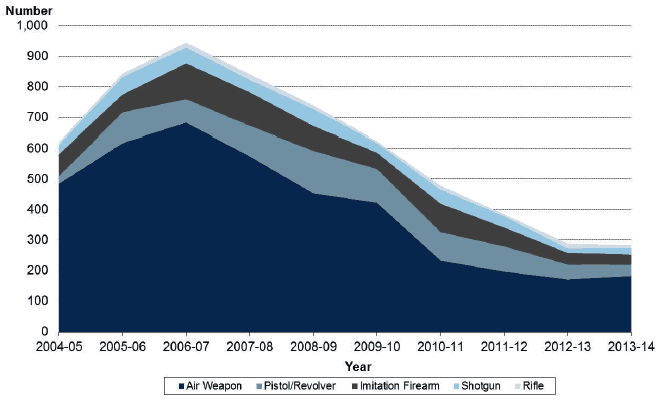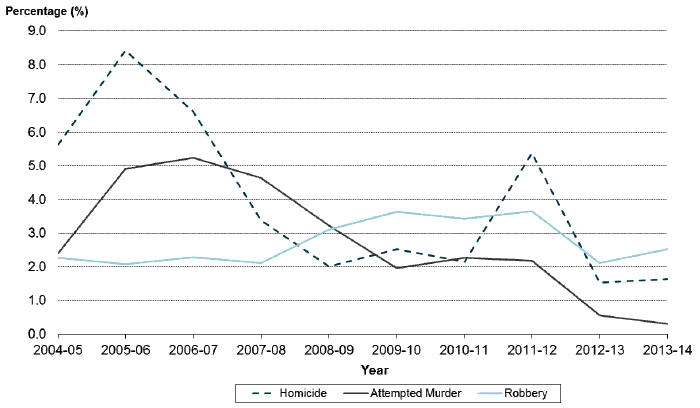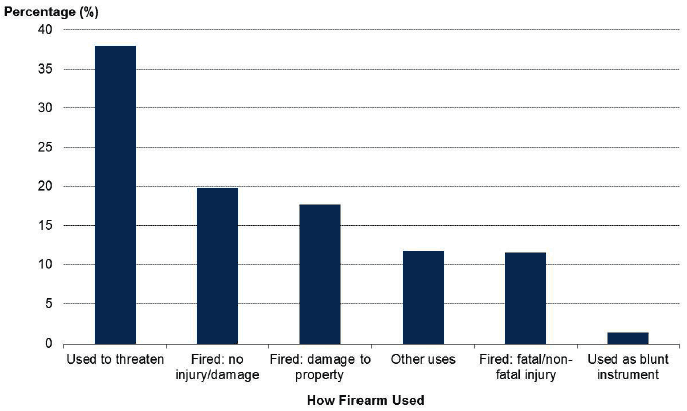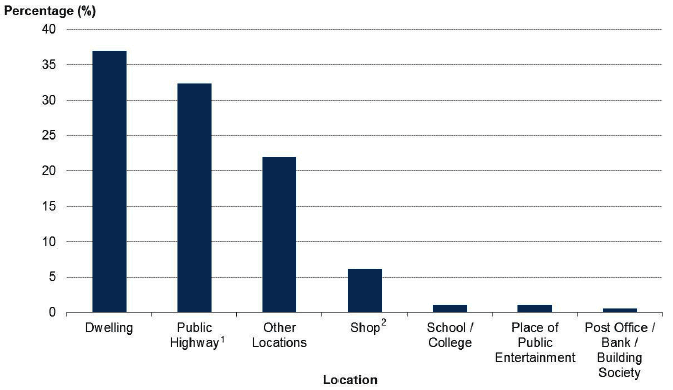Recorded Crimes and Offences involving Firearms, Scotland, 2013-14
Statistical bulletin on crimes and offences involving firearms recorded by the police in Scotland in 2013-14.
This document is part of a collection
4. Commentary
4.1 Offences involving firearms(Tables 1, 1a, 1b and 2, and Charts 1 and 2)
- In 2013-14, Scottish police forces recorded 374 offences in which a firearm was alleged to have been involved, an increase of 2% from the number recorded in 2012-13 (365). This increase follows a significant fall in the total number of offences involving firearms from 2006-07 to 2012-13
- The offence category which contained the highest number of offences involving a firearm in 2013-14 was Reckless conduct with firearms, accounting for 24% of all recorded offences involving a firearm. Reckless conduct with firearms has constituted the highest proportion (or joint highest) of offences involving a firearm for the last eight years.
- The Breach of the peace etc. offence category constituted a further 20% of offences involving a firearm in 2013-14.
- The number of common assaults involving a firearm was at its lowest number (58) in the ten-year period in 2013-14, and constituted 16% of all recorded crimes involving a firearm.
- In 2013-14, one Homicide involving a firearm was recorded, the same as the figure reported in 2012-13. There was one Attempted murder involving a firearm in 2013-14.
- The number of Serious assaults involving a firearm decreased by one offence between 2012-13 and 2013-14, reducing from six offences to five. In 2013-14 there were 38 Robberies involving a firearm, also decreasing by one since 2012-13. The number of robberies and serious assaults involving a firearm were at their lowest level in the past ten-years.
- Breach of the peace offences involving firearms increased by six, from 67 to 73 (or 9%) between 2012-13 and 2013-14.
- When air weapons and unidentified weapons are excluded, the total number of offences involving a firearm in 2013-14 decreased by 18%, from 168 offences in 2012-13 to 138 offences.
- Offences relating to the Firearms Act 1968 account for the largest proportion of offences involving a firearm (19%) when air weapons and unidentified weapons are excluded.
- The use of firearms in criminal activity continued to constitute only a small proportion of all offences recorded by the police in 2013-14, as shown in Chart 2; 1.6% of Homicides (one offence), 0.3% of Attempted murders (one offence) and 2.5% of Robberies (38 offences). Less than 0.5% of all Serious assaults, Vandalism offences and Common assaults involved the alleged use of a firearm. For further information please see Note 5.5.7.
- The Scottish Crime and Justice Survey (SCJS) measures adult experiences and perceptions of crime in Scotland (for more information see note 5.9.2). The SCJS asks victims of crime whether the offender had something they used or threatened to use as a weapon. Results from the 2012-13 survey suggest that the use of a gun constitutes only a small proportion of total offences, with 1% of those victims of crimes of violence who identified the use of a weapon referring to any type of gun as that weapon. Some caution should be taken as these estimates are based on small sample sizes and the SCJS figures are only collected when the victim had any contact with the offender. The SCJS does not collect data for all the crime groups covered by this bulletin.
Chart 2: Offences in which a firearm was alleged to have been involved, as a percentage of (selected) total recorded crimes1, Scotland, 2004-05 to 2013-14
1. For further information please see Note 5.5.7.
4.2 Main firearm recorded(Tables 3, 3a and 4, and Chart 3)
- An air weapon was used in nearly half (49%, or 182 offences) of all offences involving a firearm in 2013-14, up from 47% (171) in 2012-13. Where the firearm was identified, air weapons were used in the majority (57%) of offences involving firearms. This has been true for eight of the last ten years.
- Between 2012-13 and 2013-14, the number of offences involving air weapons (+11, or +6%) and shotguns (+6, or +40%) increased, while offences involving other identifiable firearms decreased. However, the number of offences involving unidentified weapons more than doubled from 26 in 2012-13 to 54 in 2013-14.
- In 2013-14, the number of offences involving firearms remains low by historical standards. The number of offences in 2013-14 involving imitation firearms (34) and other firearms (37) are at the lowest since 2004-05. Offences involving shotguns (21), pistols/revolvers (37) and air weapons (182) are at the second lowest levels since 2004-05.
- The one Homicide and one Attempted murder involving a firearm in 2013-14 were both committed using a pistol or revolver. A pistol or revolver was used in 29% (or 11 offences) of Robberies.
- For all other crime groups covered by this bulletin, air weapons were used more often than other types of firearms. The majority of common assaults (52%), Reckless conduct with a firearm (65%), Vandalism (92%) and Serious assaults (80%) all involved the use of an air weapon. Excluding crimes involving unidentified firearms, the majority of Breach of the peace offences (57%) and Other crimes and offences (51%) also involved the use of an air weapon.
- For offences relating to the Firearms Act 1968, air weapons were involved in 35% (17) of cases while imitation firearms were involved in 31% (15) instances.
- Chart 3 shows the total number of offences involving firearms where the firearm is identified and excluding ‘other’ firearms. It shows that air weapons have constituted a large proportion of all these offences (78% in 2013-14) throughout the period, and has been driving decline from a peak in 2006-07.
Chart 3: Main firearm recorded in offences involving the alleged use of a firearm (exc. unidentified and other firearms), Scotland, 2004-05 to 2013-14

4.3 Firearm use(Tables 5, 5a, 6, 7, 8 and 8a, and Chart 4)
- Of the 374 recorded offences involving a firearm in Scotland in 2013-14, 49% (183) resulted in the actual discharge of the firearm. This is the lowest proportion of offences that resulted in the actual discharge of the firearm since 2004-05, and is also the only year in the last ten that a majority of firearm offences did not result in a discharge. The breakdown of how the main firearm recorded was used in offences involving the alleged use of a firearm in 2013-14 can be seen in Chart 4.
- The number of offences in which a firearm was fired and caused fatal or non-fatal injury to a person decreased by 35% between 2012-13 and 2013-14 (66 to 43 offences).
- The number of offences in which a firearm was discharged causing no injury or damage increased from 62 in 2012-13 to 74 in 2013-14 (+19%). There were 66 crimes of property damage from a fired weapon, and this did not change from 2012-13.
- Of the 183 offences in which a firearm was actually discharged in 2013-14, 63% (115) involved an air weapon. Of these offences involving an air weapon, 21 resulted in non-fatal injury to a person and 55 resulted in no injury or damage.
Chart 4: How main firearm recorded was used in offences involving the alleged use of a firearm, Scotland, 2013-14
- Of the 58 Common assaults involving a firearm that were recorded in 2013-14, 23 resulted in the weapon being discharged and causing non-fatal injury. This accounts for over half (55%) of 42 recorded offences in which a firearm was fired and caused non-fatal injury.
- The increase in the total number of offences involving firearms between 2012-13 and 2013-14 was driven by offences whereby an individual was not killed or injured by a firearm. The number of instances where a firearm was Used to threaten (+13), Fired but did not result in injury (+12) and Other uses (+12) all increased from 2012-13. Where a firearm was discharged resulting in no injury, around two-thirds (66%) of these instances were classified as Reckless conduct with a firearm. Where a firearm was Used to threaten, just under two-fifths of these crimes (38%) were classified as Breach of the peace offences.
4.4 Location of firearm offences(Tables 9 and 9a, and Chart 5)
- In 2013-14, most offences involving firearms took place in a dwelling (37%) or a public highway (32%). Between 2012-13 and 2013-14, the number of offences that took place in these locations increased (+15, +12% for dwellings; +11, +10% for public highways). The number of offences involving firearms occurring in shops fell to 23 in 2013-14 from 39 in 2012-13 (-41%). Chart 5 shows the distribution of offences involving the alleged use of a firearm by location in 2013-14.
Chart 5: Location of offences involving the alleged use of a firearm, Scotland, 2013-14
1. Public highway includes roads and footpaths.
2. Shop includes shops, stalls, stores, offices and factories
- In 2013-14 there were four offences that occurred in a school/college involving the alleged use of a firearm. This is the lowest number of offences to have occurred in a school/college in the ten year period covered by this bulletin. In total, six offences involving the alleged use of a firearm occurred within banks/building societies and places of public entertainment in 2013-14. This is less than 2% of all offences involving a firearm in 2013-14.
4.5 Victim characteristics(Tables 10 and 10a)
- Of the 43 main victims who were either fatally or non-fatally injured during an offence involving a firearm in 2013-14, 31 were male (72%) and 12 were female (28%). There were no reported offences involving the shooting of a police officer causing fatal or non-fatal injury in 2013-14.
- The number of male (-10, or -24%) and female (-13, or -52%) main victims who were either fatally or non-fatally injured during an offence involving a firearm decreased between 2012-13 and 2013-14. In both cases, the number of male and female main victims were at their lowest levels in the past ten years.
- In 2013-14, 11 main victims were under the age of 16, this accounts for 26% of all main victims who were either fatally or non-fatally injured during an offence involving a firearm. This is the lowest number, in absolute and proportional terms, in the past ten years.
- Main victims aged 21 or over made up the majority (63%, or 27 victims) of all main victims who were either fatally or non-fatally injured during an offence involving a firearm in 2013-14. This compares to 45% (or 30 main victims) in 2012-13.
4.6 Clear up rates(Table 11)
- In 2013-14, 68% of all offences involving a firearm were cleared up, a slight increase of two percentage points from 66% in 2012-13. For further information on clear up rates please see Note 5.4.
- There were large variations in the clear-up rate across the different crime groups in 2013-14. Some of the most serious crime groups - Homicide (100%), Attempted murder (100%), Serious assaults (80%) and Robbery (82%) - had relatively higher clear-up rates when compared to other crime groups reported in this bulletin. These most serious crime groups account for 12% of offences involving firearms in 2013-14.
- Those crime groups with lower clear up rates, included Vandalism (33%), Other crimes and offences (43%) and Reckless conduct with firearms (59%). These crime groups combined accounted for 40% of offences involving firearms in 2013-14.
- In 2013-14, the clear-up rate for common assaults involving firearms was 74%, an increase from 65% in 2012-13.
- The clear up rate for Breach of the peace offences fell to 75%, its lowest level in the ten year period in 2013-14.
- Offences relating to the Firearms Act 1968 had a clear-up rate of 85% in 2013-14. This is a higher clear-up rate than reported for 2012-13.
4.7 Accused characteristics(Tables 12 and 13)
- The main accused was under 16 years old in 7% of cleared up offences involving the use of a firearm in 2013-14 (19 out of 254 offences). A further 23% of cleared up offences were committed by an accused aged 16 to 20 years (59 offences). Of all offences that were cleared up in 2013-14, the most common age of the main accused was 21-30 years (35%).
- In 2013-14, where the main accused was aged under 16 years old, 11 out of 19 offences involved the use of an air weapon. An air weapon was also involved in half of offences committed by a main accused aged 16 to 20 years (59) and constituted nearly two-thirds of offences where the main accused was aged 21 to 30 (47). For older age groups the proportion of firearm offences involving air weapon was lower. Where the main accused was aged 31 to 40, 32% of all firearm offences involved an air weapon, and for the 41 or over age group, 49% of firearm offences involved an air weapon.
4.8 Offences in local authorities(Tables 14, and 14a)
- When considering the trends in the number of offences in which a firearm was alleged to have been used in each local authority area, it should be noted that most local authority areas have relatively small counts of firearm offences. As a result, small changes in the number of offences in which a firearm was alleged to have been used can lead to large changes in percentage terms.
- In 2013-14, the local authority areas of Edinburgh City (54), Fife (44) and Glasgow City (37) had the highest number of offences involving firearms. This is also true once offences involving air weapons are excluded - Edinburgh (32), Fife (22), and Glasgow (12).
- In 2013-14, no offences involving firearms were recorded in East Renfrewshire, Eilean Siar, Orkney Islands, Shetland Islands and West Dunbartonshire.
- The local authorities of Aberdeenshire (+10), Edinburgh City (+10), and Fife (+12) saw the highest increases in the number of offences involving firearms between 2012-13 and 2013-14. Whereas Dumfries and Galloway (-17), North Lanarkshire (-11), Argyll & Bute (-8), and Glasgow (-8) saw the largest decreases in the number of firearm offences between 2012-13 and 2013-14.
4.9 Stolen firearms(Table 15 and 15a)
- During 2013-14, Scottish police forces recorded eleven offences in which a firearm (other than an air weapon) was stolen. Only one of these crimes involved the theft of multiple weapons.
4.10 Miscellaneous firearm offences(Table 16)
- The number of Miscellaneous firearm offences has fallen from 484 in 2012-13 to 403 in 2013-14 (-17%). This continues the recent trend, and 2013-14 has the lowest number of Miscellaneous firearm offences during the previous ten years. For further information on these Miscellaneous firearm offences, please see Note 5.2.1.
- Just under two thirds of local authority areas (66%) saw either falls or no change in the number of Miscellaneous firearm offences. Of those local authorities that recorded an increase in the number of offences in this crime classification, East Ayrshire (+15), North Ayrshire (+9), and Edinburgh City (+7) had the highest increases. Glasgow City (-26), North Lanarkshire (-15) and Fife (-14) had the highest decreases in the number of Miscellaneous firearm offences.
Contact
Email: Alastair Greig
There is a problem
Thanks for your feedback


